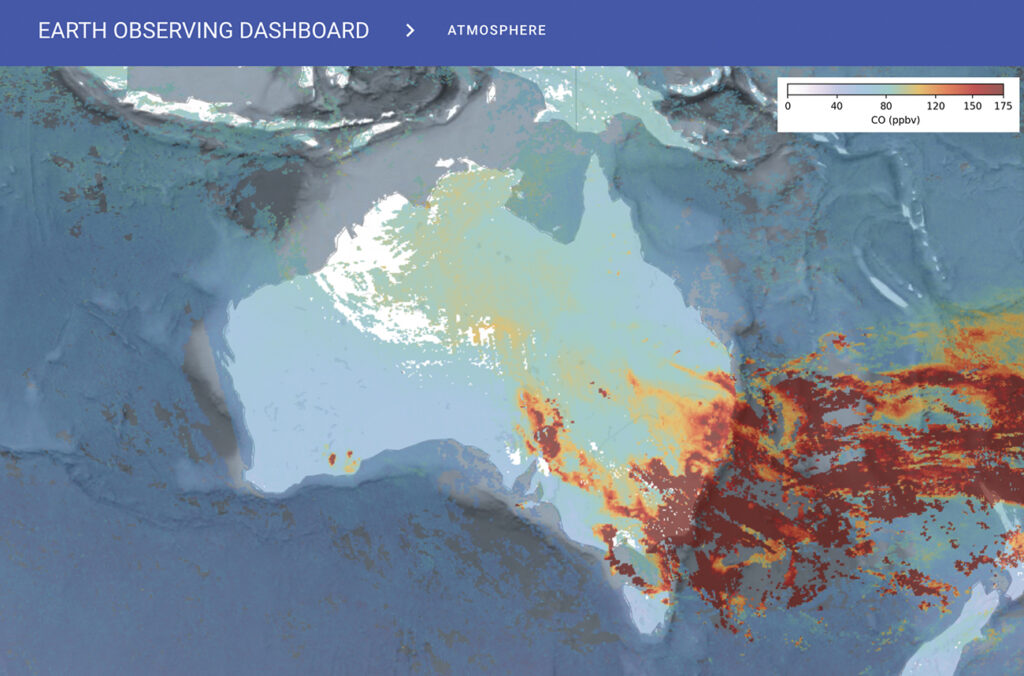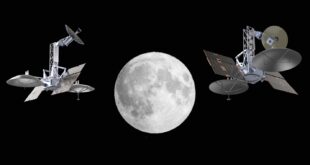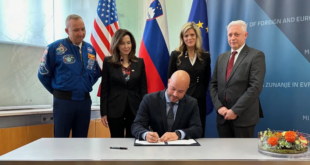By Art Cotterell

Climate change is one of the biggest challenges facing humanity today, with its devastating impacts being felt globally. Art Cotterell discusses not only the important role the space industry and Earth Observation technologies can play in helping Australia and the world be climate-ready, but the need to better communicate this message so that when the general public, decision-makers, and the next generation workforce think of space, climate action is front and centre.
Helping to fight fires from the recent wildfires in Maui to the 2019-2020 Australian bushfires. Improving agricultural practices and crop output. Mapping changing tidal patterns for better fishing. Tracking illegal deforestation in the Amazon. What all these have in common is a dependence on timely and reliable earth observation (EO) data from satellites.
“Why care about space when we have enough problems on Earth?” is a common and understandable refrain. Yet what happens up there has direct relevance to what happens down here on Earth. As GLOC, the recent inaugural Global Space Conference on Climate Change (GLOC), highlighted, it is less about the rockets and more about communicating the critical technology on-board that has real-world applications to benefit humanity. The lessons from GLOC may also benefit the Australian space ecosystem by conveying the centrality of space technology, such as Earth Observation (EO), in advancing climate science and adaptation.
An Australian space industry and agency for climate action
“Most of you all think of NASA as a space agency and as an aviation agency. It’s also a climate agency” remarked NASA Administrator Bill Nelson on a visit to Australia earlier this year. Without space technology, humanity’s ability to be climate-ready is considerably curtailed. One way that space agencies can take on this dual role of climate agencies is by making EO data available, accessible, and applicable to real-world scenarios.
EO data refers to imagery and information collected about the Earth’s land, waterways, and atmosphere via remote sensing techniques aboard satellites. EO data monitors changes to, what NASA calls the vital signs of the planet: carbon dioxide in the atmosphere, global temperature, sea levels, polar ice cap coverage, and ocean warming, among other indicators.
Enrico Palermo, the Head of the Australian Space Agency (ASA), has repeatedly spoken of the role of space in responding to climate change and disaster preparedness. In South Australia – the home state of multiple space start-ups – Deputy Premier Susan Close has also previously encouraged the domestic space ecosystem to look more at the possibility of using space technology in climate mitigation efforts.
Winyama, an Indigenous-owned and operated geospatial business, is leading a SmartSat CRC First Nations Earth Observation project to “create a set of evidence-based recommendations for current use and future [EO] capabilities and training that could best serve Indigenous communities”. Winyama Founder and Managing Director, Andrew Dowding, a Ngarluma man, has spoken on how Indigenous communities can be at the “forefront” of using EO data.
Space technology – especially EO data from satellites – is crucial to Australia’s ability to be climate-ready. When NSW was hit by record-breaking floods in 2021, EO data from the ESA’s Copernicus Sentinel-1 satellites was crucial to emergency response planning and damage assessment. Geoscience Australia was able to gain rapid access to EO data thanks to the activation of a little-known international charter: Space and Major Disasters and the European Union’s Copernicus Emergency Management Service. The 2019-2020 bushfires also saw Australia turn to international partners, Japan and South Korea, for EO data.
Space can be one of the important tools used in humanity’s efforts to be climate-ready.
The ASA has since released an Earth Observation from Space Roadmap 2021-2030 that offers a strategic approach to accessing reliable, timely, and secure EO data. The Roadmap highlights the benefits of EO for natural disaster responses; the importance of international cooperation and industry partnerships; and “ensuring Australia’s continued leadership role in promoting efficient use and dissemination of critical operational EO data in the Indo-Pacific”.
Recognition of the link between space technology and climate change was also on display at the Quad Leaders’ Summit 2023. The Quad is, relevantly, “working to expand Indo-Pacific countries’ access to and utilisation of Earth Observation data and other space-based tools to address the climate crisis, support the sustainable use of oceans and marine resources, and consult on the sustainable use of outer space”. The Quad also expressed a commitment to the “open sharing” of EO data to respond to the climate crisis.
As the 2011 floods and 2019-2020 bushfires highlight, Australia relies on international cooperation to meet our EO data needs. As the Roadmap outlines, Australia does not have its own satellite EO capabilities. In the 2022/23 Budget, funding was announced for a National Space Mission for Earth Observation (NSMEO), so that over time Australia would have its own satellite EO capabilities through the design, development, and implementation of four satellites. Funding for NSMEO was cut in June 2023 as part of “budget repair” efforts, so Australia will need to “continue to rely on international partners who currently provide crucial [EO] data”.
The Australian space industry also has international partnerships that demonstrate the importance of home-grown technology and knowledge to advancing global EO capabilities. Recently, SmartSat CRC, a leading Australian consortium of industry and research organisations, signed an agreement with the European Space Agency’s Φ-lab to collaborate further on EO. The new collaboration will look to develop sophisticated capabilities in artificial intelligence (AI), paving the way for the “next generation of predictive intelligence that can forecast and monitor agricultural and environmental activities and disaster events with greater accuracy”. Previously in 2022, NASA and the ASA signed a joint statement of intent for cooperation on EO, with Australian space technology complementing NASA’s work.
Communicating the benefits of space: less rockets, more storytelling
Despite many initiatives in Australia and around the globe that demonstrate the value add of the space industry – particularly through EO data and analytics – is there enough widespread public awareness of the role space technology plays in climate action? If not, how can these perceptions be shifted? These are questions worth considering and the learnings from GLOC on communicating the value of space may benefit the Australian space ecosystem.
At GLOC, a panel on communicating about the benefits of space for climate action, asked “Can the global space industry tell our story better?” The answer was a resounding “yes”.
Part of the “how” is the need to bring in more “storytelling” and the human component, recommended Dr Emma Gatti, Editor in Chief for SpaceWatch.Global. Rather than starting with photos or words about a rocket or a satellite, a need exists to start with what issue on the ground the technology or EO data is helping with, then work backwards to the technology itself.
Similarly, Aravind Ravichandran, Founder of TerraWatch Space, a communication and advisory firm on EO, discussed how media releases and slide decks from the space industry can sometimes focus 80% on the technology and 20% on the value added to humanity. The recommendation was made to flip this narrative: start with the human story.
Need for EO data to be available and accessible on-the-ground
Another part of the “how” is the need to make EO data timely, reliable, relevant, and accessible to the plethora of end users – that is, local communities experiencing the effects of climate change to policy and decision-makers to emergency management personnel. This means better apps, platforms, and interpretative analytics that sit on top of the data.
This means the need to listen to the voices of local communities to understand the environmental challenges being faced on-the-ground; whether and how EO data can help; the type of data needed to identify gaps; how it is collected; and questions of equity and accessibility. No “one size fits all” solution is possible.
When talking about local communities and EO data, however, it is particularly critical to centre and listen to the voices of Indigenous communities. Worldwide, Indigenous communities are stewards of land that contains 80% of the globe’s biodiversity. Indigenous-led solutions centring Indigenous Knowledge (IK) are critical to climate action efforts.
The Group on Earth Observation (GEO) Indigenous Alliance is the sole global Indigenous-led network with a vision to “protect and conserve Indigenous Cultural Heritage by using [EO] science, data, and technology to create a knowledge base that sustains the Earth we live on”. GEO Indigenous Alliance has been working in partnership with Norway’s International Climate and Forest Initiative (NICFI) Satellite Data Program on better supporting Indigenous-led innovation, use, and access of EO by and for Indigenous communities. Funded by the Norwegian Government, NICFI purchases high-resolution EO satellite imagery of the main forest regions across the world from the private sector and makes it freely available.
Recruiting a purpose-driven space workforce
Attracting people with the necessary skills and experience to realise the promise and possibilities of space is critical, and also part of the need to shift the messaging about what the space industry does, and which voices are heard.
The ASA alone aims to triple the size of the domestic space industry and generate an additional 20,000 jobs by 2030 with these figures substantially higher for the global workforce.
The messaging that the space industry not only cares about, but acts on climate change is critical to recruitment and retention. As the Space Generation Advisory Council, a global non-profit with a membership of 25,000 plus students and young professionals from 160 countries, has said: young people care about climate change and sustainability, and this informs career choices.
To attract the next generation of people looking for a purpose-driven career change, the space industry may need to do a better job of conveying the critical role space technologies play in helping with climate change. Yet this is only part of the answer, with calls for the space industry to make diversity and inclusivity a priority to attract a future workforce.
Where to next?
With climate change contributing to the intensity and prevalence of extreme weather events, humanity’s reliance on space technology such as EO data will continue to grow.
A key challenge for the space industry is to better convey the message to the general public, decision-makers, and the next-generation workforce that space is about taking climate action.
Perhaps this means less rocket imagery, and more storytelling about how on-board technology benefits local communities responding to the climate crisis. These learnings from GLOC may also assist the Australian space sector.
This is more than a re-branding exercise. Shifting perceptions and talking more beyond the space ecosystem may increase support for the space industry and bring together interdisciplinary, innovative ways of thinking on space for climate action.
This also means being guided by local communities on the ground, listening to how climate change is impacting, and then working backwards to space-based technological support such as EO. Critically, this involves centring and listening to Indigenous communities throughout the globe, with the Indigenous-led GEO Indigenous Alliance an important example.
International cooperation, private-public partnerships, and commercial initiatives also have a role to play in making EO data available, accessible and applicable to on-the-ground scenarios.
Without space technology, humanity’s ability to be climate-ready is considerably curtailed.
With the recent announcement that South Australia will host the second Advancing Earth Observation Forum in 2024, this could be but one upcoming opportunity to publicly convey the message of space for climate action. Looking further ahead to 2025, Australia’s successful bid to host the International Astronomical Congress in Sydney affords an incredible opportunity to showcase domestically and globally the Australian space industry – including the central role Australian space technologies and capabilities in EO can play in responding to climate change.
The plan by Earth Observation Australia to establish an EO for Climate Working Group is another positive step in advancing this discussion domestically, as is the Australian Centre for Space Governance’s current focus on the responsible governance of EO.
Space is not the whole answer to the climate crisis or one of its root causes. Rather, space can be one of the important tools used in humanity’s efforts to be climate-ready.
Let’s shift perceptions so that when people think of space, climate action is front and centre.
This article represents the author’s own views and was undertaken in the author’s own time as part of their PhD candidature at The University of Adelaide in Australia.
A version of this article was originally published on SpaceAustralia.com and can be read at this link.

Art Cotterell is a policy adviser, researcher, and lawyer, with a background in international policy and cooperation and legislative reform. Currently completing a PhD on the intersection of outer space and intellectual property laws through The University of Adelaide in Australia, Art’s focus is on utilising legal, regulatory, and policy frameworks to best support the R&D of space technology to benefit humanity both on Earth and in space. They also have an interest in conveying the value-add of space technology in helping with the world’s biggest challenges, and the creation of a Just, Equitable, Diverse and Inclusive (JEDI) space ecosystem.
 SpaceWatch.Global An independent perspective on space
SpaceWatch.Global An independent perspective on space




